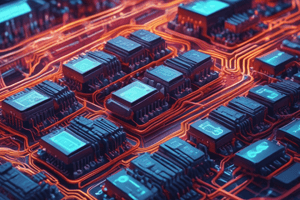Podcast
Questions and Answers
What is the primary function of the Network Layer?
What is the primary function of the Network Layer?
- To move data(frames) from one node to another node
- To handle access control and flow control
- To encode bits into signals
- To provide logical addressing and routing (correct)
What is the primary function of the Physical Layer?
What is the primary function of the Physical Layer?
- To move data(frames) from one node to another node
- To handle error control and access control
- To provide logical addressing and routing
- To transmit bits over a medium (correct)
What is the main purpose of framing in the Data Link Layer?
What is the main purpose of framing in the Data Link Layer?
- To add MAC addresses to the frame
- To synchronize the clock between sender and receiver
- To group binary data into a frame (correct)
- To control the flow of data packets
What is the purpose of access control in the Data Link Layer?
What is the purpose of access control in the Data Link Layer?
What is the term for the rate of how many number of bits sent each second?
What is the term for the rate of how many number of bits sent each second?
What is the purpose of physical addressing in the Data Link Layer?
What is the purpose of physical addressing in the Data Link Layer?
What is the purpose of error control in the Data Link Layer?
What is the purpose of error control in the Data Link Layer?
What is the term for the process of converting zeroes and ones into a signal?
What is the term for the process of converting zeroes and ones into a signal?
What is the key characteristic of circuit switching?
What is the key characteristic of circuit switching?
What is the primary function of sequence numbers in packet switching?
What is the primary function of sequence numbers in packet switching?
Which of the following is an advantage of layering in data communication?
Which of the following is an advantage of layering in data communication?
What is the key difference between datagram and virtual circuit approaches in packet switching?
What is the key difference between datagram and virtual circuit approaches in packet switching?
What is the main purpose of protocols in data communication?
What is the main purpose of protocols in data communication?
Which of the following is a phase in circuit switching?
Which of the following is a phase in circuit switching?
In a Point to Point Communication, how many nodes share the channel or medium?
In a Point to Point Communication, how many nodes share the channel or medium?
What is the characteristic of message switching?
What is the characteristic of message switching?
What is the main responsibility of the Network Layer in the OSI model?
What is the main responsibility of the Network Layer in the OSI model?
What is the main advantage of circuit switching?
What is the main advantage of circuit switching?
What is an exploit in the context of Computer Network Security?
What is an exploit in the context of Computer Network Security?
What is the purpose of Network Security?
What is the purpose of Network Security?
In a Point to Multipoint Communication, how many nodes share the channel or medium?
In a Point to Multipoint Communication, how many nodes share the channel or medium?
What type of transmission mode allows data to flow in one direction?
What type of transmission mode allows data to flow in one direction?
What type of transmission mode allows two devices to send and receive at the same time?
What type of transmission mode allows two devices to send and receive at the same time?
What is the responsibility of the Data Link Layer in the OSI model?
What is the responsibility of the Data Link Layer in the OSI model?
What is the purpose of a firewall in network security?
What is the purpose of a firewall in network security?
What is the primary purpose of Intrusion Detection and Prevention Systems (IDS/IPS)?
What is the primary purpose of Intrusion Detection and Prevention Systems (IDS/IPS)?
What is the main benefit of network security?
What is the main benefit of network security?
What is the main reason why organizations need network security?
What is the main reason why organizations need network security?
What is the primary purpose of a Virtual Private Network (VPN)?
What is the primary purpose of a Virtual Private Network (VPN)?
What is the purpose of Network Access Control (NAC)?
What is the purpose of Network Access Control (NAC)?
What is an exploit in the context of cybersecurity?
What is an exploit in the context of cybersecurity?
What is the purpose of Anti-Malware and Anti-Virus Software?
What is the purpose of Anti-Malware and Anti-Virus Software?
What is the primary purpose of Data Loss Prevention (DLP)?
What is the primary purpose of Data Loss Prevention (DLP)?
What is the purpose of Secure Email Gateway?
What is the purpose of Secure Email Gateway?
Which of the following is a feature of Web Security Gateway?
Which of the following is a feature of Web Security Gateway?
What is the purpose of Network Segmentation?
What is the purpose of Network Segmentation?
What is SQL Injection?
What is SQL Injection?
What is the primary purpose of Identity and Access Management (IAM)?
What is the primary purpose of Identity and Access Management (IAM)?
What is the purpose of Wireless Security?
What is the purpose of Wireless Security?
What is a component of Security Information and Event Management (SIEM)?
What is a component of Security Information and Event Management (SIEM)?
Flashcards are hidden until you start studying
Study Notes
Network Fundamentals
- Circuit switching: a dedicated path is established between sender and receiver before data transfer
- 3 phases: connection establishment, data transfer, connection disconnection
- Example: telephone network
- Message switching: store and forward mechanism, message is transferred as a complete unit
- Packet switching: message is broken into individual packets, each with source and destination IP address and sequence number
- 2 approaches: datagram packet switching (connectionless) and virtual circuit packet switching (connection-oriented)
Network Layers
- Layering: decomposing problem into manageable components (layers)
- Advantages: modular design, easy troubleshooting
- Network Layer: provides logical addressing, routing
- Data Link Layer: responsible for moving data (frames) between nodes
- Services: framing, physical addressing, flow control, error control, access control
- Physical Layer: responsible for transmitting bits over a medium, provides electrical and mechanical specifications
- 2 kinds of medium: wired and wireless
Physical Layer
- Physical characteristics of medium: determines type of medium (wired or wireless)
- Representation of bits: encoding (converting 0s and 1s into signal)
- Data rate: transmission rate (number of bits sent per second)
- Synchronization of bits: clock synchronization between sender and receiver
- Line configuration: point-to-point communication (single channel/medium) vs. point-to-multipoint communication (shared channel/medium)
- Physical topology: type of network topology
- Transmission mode: simplex (one-way), half-duplex (two-way, not simultaneous), full-duplex (two-way, simultaneous)
Computer Network Security
- Network security: protection of underlying networking infrastructure from unauthorized access, misuse, or theft
- Combines multiple layers of defenses at the edge and in the network
- Exploits: programs or code designed to find and take advantage of security flaws
- Types of network security:
- Firewall security
- Intrusion Detection and Prevention Systems (IDS/IPS)
- Virtual Private Network (VPN)
- Anti-malware and anti-virus software
- Network Access Control (NAC)
- Data Loss Prevention (DLP)
- Secure Email Gateway
- Web Security Gateway
- Wireless Security
- Network Segmentation
- Security Information and Event Management (SIEM)
- Identity and Access Management (IAM)
Network Threats
- SQL injection: type of cyber attack that manipulates SQL queries to execute malicious code on a database
Studying That Suits You
Use AI to generate personalized quizzes and flashcards to suit your learning preferences.




